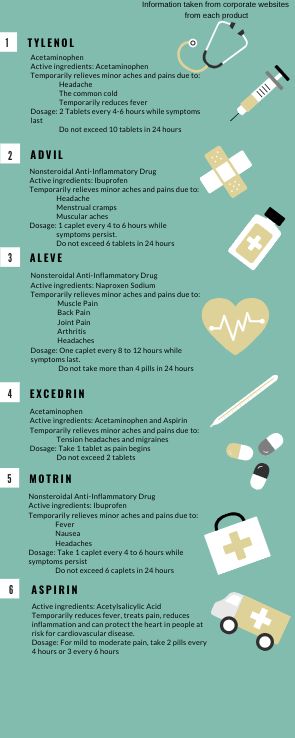Many know the feeling of grabbing the white palm sized container, filled with the red, blue or white pills and the feeling of amazement that something so small contains the power to heal any type of pain felt by the body.
According to Understanding Trust in Over-the-Counter Medicines: Consumer and Healthcare Provider Perspectives, on average, two-thirds of consumers prefer taking an over the counter medication over a prescription when available. These types of over the counter brands can be found anywhere, from local drug stores to supermarkets worldwide. Down the pharmacy aisle, many different bottles and labels of over the counter pain medications are provided to consumers for any type of aches and pains they may experience. The mistake most people make though, is popping the wrong type of pill for the pain they are experiencing from the lack of knowledge of the different classifications of over the counter products.
“I have Advil, Tylenol and ibuprofen in my house,” junior Samantha Salmi said. “[I use] them all for different things because of my different experiences with them. I might take Advil because it is convenient, but I know to take ibuprofen when my hands start to hurt from playing my instrument.”
The National Food and Drug Association classifies drugs into two categories: acetaminophen and nonsteroidal anti-inflammatory drugs (NSAIDs). Anti-inflammatory drugs are meant for the everyday aches and pains like common tension headaches, minor sprains or soreness. Acetaminophen is a fast release drug that relieves pain quickly, but does not reduce inflammation within the body. According to Jim Morelli, a pharmacist and author of “Pain Management Medication Types,” NSAIDs act on the different substances within the body that causes inflammation, pain and fever. The other classification, acetaminophen, increases the body’s pain threshold, but does not affect inflammation in the body.
In the first initial moments of feeling pain, the common reaction among most people is to take medication to relieve the uncomfortable feeling of pain. But what happens after one takes the pill?
KidsHealth explains how the body endures and handles pain. Inside the body, tiny nerve endings can sense pain, such as from a burn or a blow to a body part. After ingestion, pain relievers work with the nerve endings and the brain to keep the feeling of pain at bay. Even though the body is covered with these nerve endings, only some can sense when these cells are injured or damaged. A hormone called prostaglandin is released, which is known to increase the perception of pain, fever, redness and inflammation that occurs with a body trauma.
When prostaglandin is released, the nerve endings send messages to the brain. They tell the brain about the location of the pain along with deciphering what the pain feels like. When a pain reliever is taken, it blocks the receptors in the damaged cells from feeling the prostaglandin chemicals. This in turn means that the brain will not get the pain message as quickly or clearly. A sharp pain can be masked as a dull ache makes it manageable for the body and less to worry about.
Common household brands including Aleve, Advil and ibuprofen are all NSAIDs and can be used to treat swollen joints and soreness. The active ingredients within the medications are slower release, which may take time to feel the effect but is longer lasting. Acetaminophens like Tylenol are often used to break a fever and treat an unexpected headache or growing pains. The active ingredient works in the brain to suppress signals so the pain endured can not be felt.
“I never really thought about how different over the counter pain medications can be from each other,“ freshman Ayden Jones said. “I always assumed that all of them did the same thing.”
Even though most of the brands within the same classifications do the same thing, mixing up the classification and the type of pain felt may do the body harm or not get the desired relief. Knowingly combining two different pain relievers is a risky practice. If taking an NSAID, like Advil, helps with sore joints, but later that day one takes another over the counter product, like Tylenol for a cold, then an overdose may occur. Taking higher than the recommended dosage of NSAIDs and acetaminophen can also increase the risk of stomach ulcers and bleeding.
So, what does that mean for consumers? It is important to know the classification of the medications and what the chemicals they consist of do to the body. When purchasing an over the counter product, read the label for ingredients. This ensures that double dosing does not occur and the pain being experienced can be relieved with the correct medications.
















![The Black Lives Matter movement has become a growing trend in recent years. "Everything people post on Instagram and everything [related to] politics is a trend now" sophomore Kelsey Aviles said. Despite how serious of a topic it is, some individuals post about BLM specifically because it is trendy.](https://www.sequoitmedia.com/wp-content/uploads/2020/12/Untitled-Artwork-3-900x318.jpg)